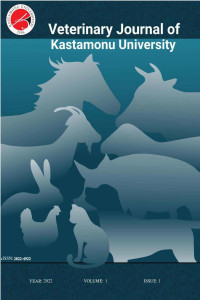Abstract
References
- Alim, A. (1995). Sivas İl ve İlçe Merkezlerinde İçme Sularının Bakteriyolojik Analizi. Yüksek Lisans Tezi, Erciyes Üniversitesi.
- AOAC. (1984). Official Methods of Analysis. Association of Official Analytical Chemists. Arlington.
- Bilgin, M. (2003). Niğde İli İçme Sularının Fiziksel, Kimyasal ve Mikrobiyolojik Olarak İncelenmesi. Yüksek Lisans Tezi, Niğde Üniversitesi.
- Can, M. (2000). Balıkesir Yöresinde İçme Suyu Olarak Kullanılan Kuyu Suları ve Çeşme Sularının Fiziksel Kimyasal ve Mikrobiyolojik Olarak İncelenmesi. Yüksek Lisans Tezi, Trakya Üniversitesi.
- Çakır, İ., Doğan, H.B., Başpınar, E., Keven, F., & Halkman, A.K. (2002). The need for confirmation in coliform and E. coli Enumeration in foods. Turkish Journal of Veterinary and Animal Sciences, 26, 1049-1053.
- Delpla, I., Legay C., Proulx, F., & Rodriguez, M.J. (2020). Perception of tap water quality: Assessment of the factors modifying the links between satisfaction and water consumption behavior. Science of the Total Environment, 722, 137786. https://doi.org/10.1016/j.scitotenv.2020.137786
- Harrigan, W.F. (1998). Laboratory Methods in Food Microbiology. (3rd Ed). London: Academic Press.
- Koçak, Ö. & Güner, A. (2009). Erzurum il merkezindeki içme ve kullanma sularının kimyasal, fiziksel ve mikrobiyolojik kalitesi. Atatürk Üniversitesi Veteriner Bilimleri Dergisi, 4(1), 9-22.
- Koksal, F. & Samastı, M. (2007). İstanbul’ da polikarbonat damacanalarda satılan içme sularının bakteriyolojik incelenmesi. Türk Mikrobiyoloji Cemiyeti Dergisi, 37(4), 221- 224.
- Proulx, F., Rodriguez, M. J., Sérodes, J. B., & Miranda, L. F. (2010). Factors influencing public perception and use of municipal drinking water. Water Science and Technology, 10(3), 472-485. https://doi.org/10.2166/ws.2010.511
- Resmi Gazete. (2005). İnsani Tüketim Amaçlı Sular Hakkında Yönetmelik. Başbakanlık Basımevi, 25730.
- Robertson, W., & Brooks, T. (2003). The role of HPC in managing the. Heterotrophic Plate Counts and Drinking-water Safety: The Significance of HPCs for Water Quality and Human Health, 233.
- Tolgay, Z. & Tetik, I. (1964). Muhtasar Gıda Kontrolü ve Analizleri Kılavuzu. Ege Matbaası.
- Tuluk, B., & Orhan, F. (2017). Comparison of tap water with bottled natural spring water in terms of some quality parameters in Erzurum. International Journal of Agricultural and Natural Sciences, 10(2), 27-32.
- Türk Standardları Enstitüsü. (2005). TS-266 Sular, İnsani Tüketim Amaçlı Sular. Türk Standardları Enstitüsü.
- WHO. (2011). Guidelines for Drinking-Water Quality, (4th ed.). World Health Organisation.
Abstract
In this research, the chemical and microbiological quality of 20 tap water samples were randomly selected from Bingöl University in Bingöl. The Heterotrophic Plate Counts (HPC) numbers of samples were 1.09 ± 0.4 logs CFU/ml. The coliform and fecal coliform bacteria were not detected in all samples. The average pH value of samples was 6.79 ± 0.15 and all samples were nitrate negative, nitrate positive, qualitatively. The average hardness values of the water samples were determined as 6.16 ± 2.47 ºf. It can be said that all samples are classified as soft water. As a result, it is thought that tap water's simple chemical and microbiological quality in Bingöl University is sufficient for drinkability, However, this thesis should be supported by forwarding microbiological, chemical, and sensory analyses.
References
- Alim, A. (1995). Sivas İl ve İlçe Merkezlerinde İçme Sularının Bakteriyolojik Analizi. Yüksek Lisans Tezi, Erciyes Üniversitesi.
- AOAC. (1984). Official Methods of Analysis. Association of Official Analytical Chemists. Arlington.
- Bilgin, M. (2003). Niğde İli İçme Sularının Fiziksel, Kimyasal ve Mikrobiyolojik Olarak İncelenmesi. Yüksek Lisans Tezi, Niğde Üniversitesi.
- Can, M. (2000). Balıkesir Yöresinde İçme Suyu Olarak Kullanılan Kuyu Suları ve Çeşme Sularının Fiziksel Kimyasal ve Mikrobiyolojik Olarak İncelenmesi. Yüksek Lisans Tezi, Trakya Üniversitesi.
- Çakır, İ., Doğan, H.B., Başpınar, E., Keven, F., & Halkman, A.K. (2002). The need for confirmation in coliform and E. coli Enumeration in foods. Turkish Journal of Veterinary and Animal Sciences, 26, 1049-1053.
- Delpla, I., Legay C., Proulx, F., & Rodriguez, M.J. (2020). Perception of tap water quality: Assessment of the factors modifying the links between satisfaction and water consumption behavior. Science of the Total Environment, 722, 137786. https://doi.org/10.1016/j.scitotenv.2020.137786
- Harrigan, W.F. (1998). Laboratory Methods in Food Microbiology. (3rd Ed). London: Academic Press.
- Koçak, Ö. & Güner, A. (2009). Erzurum il merkezindeki içme ve kullanma sularının kimyasal, fiziksel ve mikrobiyolojik kalitesi. Atatürk Üniversitesi Veteriner Bilimleri Dergisi, 4(1), 9-22.
- Koksal, F. & Samastı, M. (2007). İstanbul’ da polikarbonat damacanalarda satılan içme sularının bakteriyolojik incelenmesi. Türk Mikrobiyoloji Cemiyeti Dergisi, 37(4), 221- 224.
- Proulx, F., Rodriguez, M. J., Sérodes, J. B., & Miranda, L. F. (2010). Factors influencing public perception and use of municipal drinking water. Water Science and Technology, 10(3), 472-485. https://doi.org/10.2166/ws.2010.511
- Resmi Gazete. (2005). İnsani Tüketim Amaçlı Sular Hakkında Yönetmelik. Başbakanlık Basımevi, 25730.
- Robertson, W., & Brooks, T. (2003). The role of HPC in managing the. Heterotrophic Plate Counts and Drinking-water Safety: The Significance of HPCs for Water Quality and Human Health, 233.
- Tolgay, Z. & Tetik, I. (1964). Muhtasar Gıda Kontrolü ve Analizleri Kılavuzu. Ege Matbaası.
- Tuluk, B., & Orhan, F. (2017). Comparison of tap water with bottled natural spring water in terms of some quality parameters in Erzurum. International Journal of Agricultural and Natural Sciences, 10(2), 27-32.
- Türk Standardları Enstitüsü. (2005). TS-266 Sular, İnsani Tüketim Amaçlı Sular. Türk Standardları Enstitüsü.
- WHO. (2011). Guidelines for Drinking-Water Quality, (4th ed.). World Health Organisation.
Details
| Primary Language | English |
|---|---|
| Subjects | Veterinary Surgery |
| Journal Section | Research Articles |
| Authors | |
| Publication Date | June 30, 2022 |
| Submission Date | May 12, 2022 |
| Published in Issue | Year 2022 Volume: 1 Issue: 1 |


